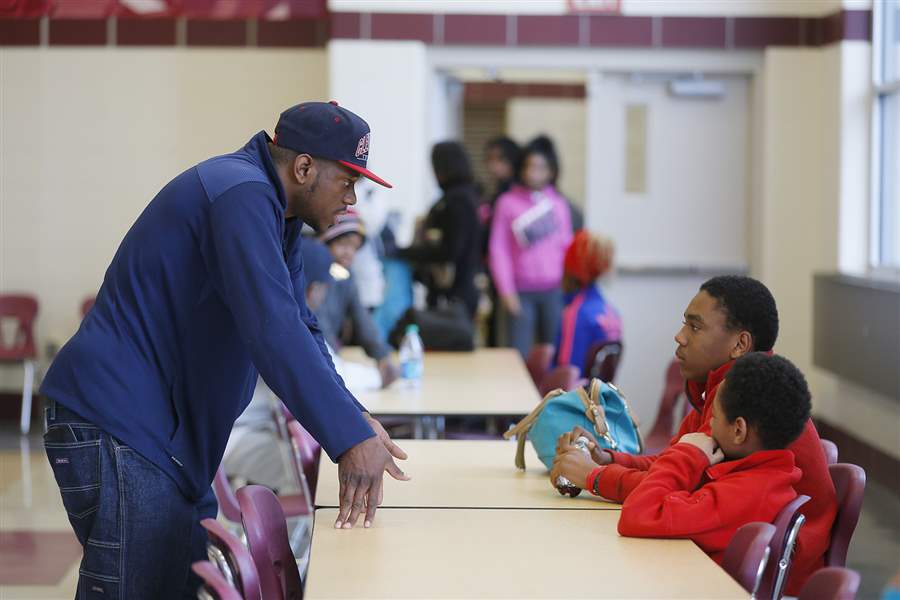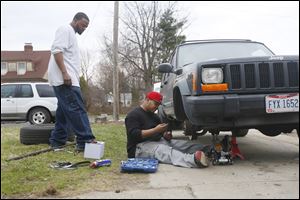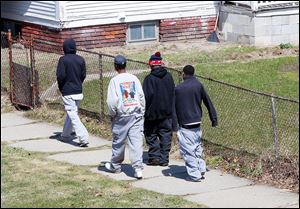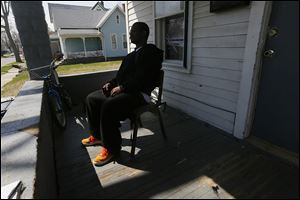
BATTLE LINES REVISITED
Answers hard to find, but streets in Toledo quieter, violence falling
4/27/2014
Wrestling coach Roshawn Jones, left, talks to brothers Ayden Braziel, 14, center, and Rayvon Braziel, 10, right, in Scott High School’s cafeteria about joining his central-city gym, Soul City Boxing and Wrestling.
THE BLADE/AMY E. VOIGT
Buy This Image

Wrestling coach Roshawn Jones, left, talks to brothers Ayden Braziel, 14, center, and Rayvon Braziel, 10, right, in Scott High School’s cafeteria about joining his central-city gym, Soul City Boxing and Wrestling.
When he was 23 years old, he no longer felt like he belonged.
Too many homies dead or locked up.
Twelve days after finishing a 90-day sentence at the Correctional Treatment Facility he saw his best friend face down on a central-city parking lot, dead from a single gunshot wound in the back of the head.
Dead at 20 because of a song.
Wooty woo la la la.
“That day I stopped messing with everybody. I said I was cool with the gang stuff,” said the member of the Manor Boyz, a Bloods gang, who spoke on the condition of anonymity fearing being branded as a snitch. “I got too many dead homies. Too many brothers in jail.”
RELATED LINK: Battle Lines: Gangs of Toledo
RELATED LINK: The Blade's gang map

Members of the Toledo Police Gang Task Force question a suspected gang member after they had been alerted to violence in the neighborhood on Hobart Street during the task force’s night shift.
His friend died a little more than a year ago, just days before The Blade introduced this gang member — and others — in “Battle Lines: Gangs of Toledo,” a four-day series that aimed to show the perils of life in some of Toledo’s toughest neighborhoods and how gangs here became so prevalent and dangerous.
In the year since those stories, life has changed for each of the people interviewed. Nearly all have lost a friend or family member to violence. Some have distanced themselves from the streets, and some reaffirmed and strengthened their gang ties. Others were released from lockup only to find themselves behind bars again.
Some, like “Kid,” a female XBlocc gang member, and “Maniac,” who is wanted by police for skipping out on bond, couldn’t be reached for follow-up. Some didn’t want to be reached.
Gangs are still very real and still present problems for police and different neighborhoods, but some say the landscape is shifting, and Toledo is a safer city now than it was even a year ago. Others are just waiting for the next violent outburst.

Quieter nights
When the night air was hot, so were the streets. Gas-station parking lots were crowded with cars on big, shiny rims and slick, glimmering paint jobs. The girls danced to bass-heavy beats that rattled windows, and the boys were happy to watch.
Two years ago, night after night, that scene played out around Toledo, but in the last year, something changed. The nights, though they aren’t necessarily calm, are quieter.
It could be the weather. Perhaps it’s the police cameras with the flashing blue lights. Maybe the right people — the ones with an overwhelming tendency to solve their problems from behind a gun — are in jails and prisons. It could be that the gang lifestyle has lost its appeal. Maybe people are sick of all the death.
Could be any of a hundred reasons, probably a dash of truth in each.
“It’s quiet. Much slower than it has been in the past,” said Toledo police Lt. Ed Bombrys, who oversees the department’s gang unit. “In the last six weeks you’ve got to believe the weather has definitely been a factor. We’ll have to see as the year goes on, you know, what other things have had an effect positively or has it not had the effect we have hoped for.”
What is certain is that violent crime in Toledo is down.
So far this year, there have been 30 shootings, three fatal. By this time in 2013, there were 35 shootings with four fatalities, and 62 shootings with six fatals in 2012.

Aaron Belton, left, and his brother Chris Belton, work on fixing Chris Belton’s vehicle in front of their house. Aaron, 27, once involved with the Lil Heads gang, has pushed himself away from the streets. Chris, 25, wrote and produced the rap song ‘My City.’ He and his manager plan to release the album next month.
Willie Knighten, Jr.
Willie Knighten, Jr., is the leader of a new kind of Toledo gang.
Their identity isn’t tied to a neighborhood, color, ride-or-die attitude. They’re not using guns to fight; they’re armed with jobs and the idea of a better life for their families.
An army of Tyros, men worth following, nurtured while incarcerated and told by Knighten, through the Ridge Project, that they can be better versions of themselves.
“It seems like we get bigger every single day,” said Knighten, 42, a former gang leader who served 13 years in prison for a murder he says he didn’t commit. He was ordered to spend his life in prison, though the sentence was later commuted.
Knighten, upon his release, was hired by the Ridge Project to teach its program to incarcerated men — most of whom have children, many with gang affiliations — to be better fathers. Those men, “Tyros,” are challenged to find jobs and to share what they’ve learned with the other men in their communities.
Knighten credits those men — positive messengers — as a reason for a drop in the city’s gang violence.
In the last year, though, Knighten has lost young men who grew up in his central-city neighborhood. Fred Watson, Jr., 20, was shot dead while sitting in a car parked at Avondale and Brown avenues on June 16. No one has been charged for that killing. Two more neighborhood youths, Rishad Williams, 21, and Tyrone Hoskins, Jr., 23, are in the Lucas County jail awaiting trial for a Feb. 2 shooting death.
Quincy Allen, 22, another neighborhood man who was Watson’s best friend, was sentenced March 13 to life in prison for the April 19, 2013, gang-related shooting death of La’Quan Dunbar.
Knighten’s cousin, Thressea James, 26, was walking along North Detroit Avenue near Willamont Road when she was hit by a driver on Feb. 21; her body was later found, and she was pronounced dead at the scene.
“I lost and I lost. It hurts,” Knighten said. “Any death hurts, but to die young, and especially a violent death. You know, I’m tired of R-I-P shirts. I’ve never worn one. Ever. Never worn one. I want to go back to the day when we die old and wear suits to funerals.”
In every loss, he looks for victory. Two of the men who were in Knighten’s class at the Correctional Treatment Facility last year — the Manor Boy and “Chaos,” who was involved with the Southside Folks — are living up to the standards the Tyro program put in place.
“To see any man that comes out and walks the walk and talks the talk is beautiful,” Knighten said.

Twins Devon, center right, and Davon Lewis, back in the sweatshirt and sweatpants, walk with their friends. The brothers don’t go to Soul City Boxing as often as they have in the past.
The Manor Boy
Home for less than two weeks and planning for a funeral.
“Everybody I mess with is dead or in jail,” said the 23-year-old Manor Boy.
It was early on April 19 last year when the phone rang: La’Quan is dead.
They raced to the Gas & Go on North Detroit Avenue. They had to see for themselves.
There he was, face down. Not moving. Bleeding.
“That’s my best friend. That’s my boy. I love that man to death,” the Manor Boy said. “I was salty. I was so mad for the fact he called me that day and I said I ain’t going to go out. … If I’d have went, on Kent, my boy wouldn’t be dead. I can’t say that, because we both probably would have been dead.”
La’Quan Dunbar, 20, was killed because of his gang affiliation to the Manor Boyz. Others from the gang wrote and produced a song, “Wooty Woo La La La,” and posted it online. The lyrics rip on Crips gangs and explicitly disparage two teens from rival neighborhoods who were shot dead in previous years.
One of the teens mentioned was Deontae Allen, 19, who was killed Oct. 18, 2012, by Traquawn Gibson, a Manor Boy. Deontae Allen was the brother of Quincy Allen, who was convicted of shooting and killing La’Quan Dunbar.
“I ain't gonna lie, when I first seen that I said [expletive] that,” the Manor Boy said. “On Kent, I’ll do 25 for my boys. … [My friends were] talking about ‘Let’s ride, let’s ride.’ I couldn’t do it, man. I couldn’t do it ’cause I know ’Quan would have said ‘Why you gonna do all this? You got a son.’ ”
Compare that reaction to when that Manor Boy’s relative, Montrese Moore, 19, was killed by a rival gang member March 16, 2012. That night, the Manor Boy took his gun, got into a car, and drove through the south-end neighborhood where the killer lived and opened fire on anything he saw.
That’s what the streets taught him to do.
For years his options were death or incarceration. Hear it enough, and it starts to make sense.
No one said, “You can do better.”
During his 90 days in the Correctional Treatment Facility, Knighten tried to change that. He said, “You can do better.”
“That’s my mentor now,” the Manor Boy said of Knighten. “ … He talking about how he gonna keep me out of trouble. He can’t keep me out of trouble. I got to keep myself out of trouble ’cause can’t nobody make my decisions. I make my own decisions. I ain’t going back to jail.”
Since his April 7, 2013, release, the Manor Boy moved away from his gang and lives in a rival territory, trying to keep a low profile.
He has a job in a factory where he moves and stacks boxes. It isn’t glamorous, and the pay isn’t great, but it’s not the fast cash that gets you killed.
“I’m just tired of this life,” he said. “I’m tired of living this life. I’m tired of worrying about if [someone is] trying to smoke me.”
On patrol
A man sitting on a curb in Toledo’s central city pushed up a cuff on his long-sleeved T-shirt to show a Toledo police gang unit officer his tattoos.
“Nine hundred?” asked Officer Reuben Jurva. “What’s that mean?”
“It’s the number of days I’ve been alive,” the man told him.
The officers laughed. Casual conversation and intelligence-gathering while other officers checked each of the dozen-or-so men in front of 949 Vance St., a house police say is known for trouble, for warrants.
The 900 represents the gang he and his friends affiliate with, 900, a Folks gang that is known to hang out in the 900 block of Vance Street.
Though home base is on Vance, that gang and others are becoming harder to track down as they mobilize to other spots around the city, police said.
“They’re always moving, always changing,” Lieutenant Bombrys said. “I think in the old days … you could always find them in one spot, in one territory. … Part of the job is trying to figure out where they’re at, where they’re hanging.”

A former member of the Manor Boyz sits on the porch of a family member’s home and talks about the past year of his life. But not everyone has left the streets.
Soul City
Soul City Wrestling and Boxing gym has outgrown its small building at Junction and Belmont avenues.
When the central-city boxing gym, situated in a corner building above a barber shop, partnered with Choices, a mental health program, to make memberships free for children, its roster of athletes doubled, said Roshawn Jones, 24, who owns the gym with his father, Otha Jones, Jr., 44.
“We went from saving 25 to 30 kids’ lives to saving 60 to 70 kids’ lives,” the younger Jones said.
Choices pays the gym the monthly membership fee for each child and then bills Medicaid; they host daily meetings with the youths, talking about gangs and bullying and drugs and other challenges they might face.
Because so many boys and girls are training at the gym, the father-son coaching duo is looking for a larger space. Although the original plan was to move into the suburbs, the strategy now is to stay close to at-risk populations. Those are the type of youths who are turning to Soul City.
One of the boys who goes to the gym is on the fringe of being a success and being consumed by the streets. He posts on Facebook status updates with gang slang and photos of him wrenching his fingers to represent his block.
“Kids know that’s going to make them popular. If you gang bang, shoot, throw up gang signs, it’s going to make you popular and make all the girls want you,” the younger Jones said.
There was another boy who showed promise but could have gone another way.
Denton Yates was 11 when he started visiting Soul City. His twin brothers, Devon and Davon Lewis, 14, soon followed.
Denton was good, but he wasn’t focused. He sometimes latched on to the gang talk his brothers spewed; it distracted him in school, it worked against him in the ring.
In the gym, the twins started to do better, but medical problems barred them from continuing. Once they stopped boxing, trouble seemed to find them.
Not wanting Denton to be caught up in the same web, Otha Jones moved the boy into his home.
“We decided it would be better to just take him in and get the best of him that way,” Otha Jones said. “He’s actually doing great.”
Denton, a seventh grader at Robinson Elementary School, said his grades have improved: In the second quarter this year he failed five classes. In the third quarter he failed one. Language arts, he said, is the hardest.
He says he’s improving in the gym, too. His record of 15-4 shows as much.
“I just think that I wasn’t focused enough to, like, do better, but now I am,” he said. “I think I didn’t want to do better.”
Denton says he worries about his older brothers, who still hang out around some of the other boys who talk about the Lil Heads, a Bloods gang in their neighborhood.

Willie Knighten, Jr., an ex-gang member who works for The Ridge Project, trains Dominic Vasquez, a former gang member and new ‘Tyro,’ for a job. Knighten helps teach incarcerated men how to get off the dangerous streets.
The Beltons
Chris Belton was on his way home from his second-shift job at Chrysler and was confused about the 3 a.m. gathering at a gas station at South Byrne Road and Hill Avenue.
“I saw my cousin and a couple friends and they told me, like, ‘Marv just got shot.’ ”
At the hospital, not allowed to see his cousin, Marvin Smith, Jr., Mr. Belton went home.
“It was like 6 o’clock in the morning; I heard my mom scream upstairs so I already knew what happened.”
Smith, 24, was shot by armed security guards outside Lighthouse Banquet Hall and Clam Diggers, 2605 Broadway, reportedly after Smith opened fire and twice shot an unarmed guard. Smith was found alive between two parked cars but died at a hospital several hours later.
In the days and anguish that followed, Mr. Belton, 25, who wrote and produced “My City,” a rap song for the gang series, nearly decided to quit making music.
“Marv was the reason I started making music in the first place, so it was kind of a big deal for me,” said Mr. Belton, whose stage name is Jimmy Paid. “ … I almost stopped making music after that, but I realized I can’t just stop because he’s the reason I’m doing it in the first place.”
In the last year, Mr. Belton started working full time, incorporated his record label, Flip Cash, and hired a manager. With the manager’s help they remastered his album and plan a new release May 13. He also performed at Miserable City TV’s birthday party on 419 Day.
“We ain’t trying, we gon’ take over for real,” said Aaron Belton, Mr. Belton’s older brother.
Aaron Belton, 27, who recently landed a factory job, used to associate with the Lil Heads, said since the gang series, he pushed away from the streets.
“What I’m doing is completely taking my focus completely off of that, so I’m not worried about that because that’s a big circle that everybody is running in,” Aaron Belton said.
“I’m tired of running in circles. I’m trying to just keep moving.”
Contact Taylor Dungjen at tdungjen@theblade.com, or 419-724-6054, or on Twitter @taylordungjen.